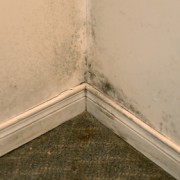Surface Mold Removal
The FreshStart mobile service Technicians will help with your mold removal and break the cycle of continuing contamination and re-contamination that often spread these pollutants throughout the home, office, commercial structure or public building. To assure the efficacy and safety of the FreshStart process it is important that there is adequate preparation of the area to be treated.
There are many types (species) and levels of molds found inside virtually all buildings. Although knowing the type of molds that may be present within the building may be important, research and clinical studies have established that with proper preparation the FreshStart process eliminates the viability (the ability to grow, reproduce or produce harmful toxins) of all common molds. To prepare for the FreshStart process , there are a few necessary observations. In virtually every case mold grows due to the presence of water and a food source (typically building materials such as wood and/or drywall/sheetrock). The absence or low levels of light and inadequate air circulation are also common factors in creating indoor mold infestations.
Step 1 Determine the Source of the Water
The first step in mold removal addressing a mold problem is to determine the source of water. The most common sources of water intrusion are: 1.) broken pipe or plumbing seal, 2.) leak in roof, 3.) open space around door or window, 4.) accumulated ground water adjacent to the structure due to improper drainage, 5.) misdirected sprinkler heads and 6.) high ambient humidity.
Step 2 Eliminate Source of Water Intrusion
The second step in mold removal is to eliminate the source of the water intrusion. Depending on the amount of water and the length of time that the water intrusion has been present, the solutions vary widely from adding a dehumidifier to hiring a professional mold remediation contractor. A generally accepted standard for determining when to hire a professional mold remediation contractor was developed by the City of New York, which paraphrased says; “ . . . when there is more than 10 sq. ft. of visible mold with structural damage to the building materials in the area of infestation, it is advisable to use a licensed professional contractor. PLEASE NOTE: constantly developing requirements vary by State, County, City and Homeowner Association rules and regulations, so be sure to check with the appropriate authorities if the infected area is greater than 10 sq. ft.
Step 3 Remove All Mold Damaged Materials
The third step in mold removal is to remove all damaged and/or mold stained materials. This can be as easy as removing a pile of wet rags or soaked paper boxes to as complex as removing entire walls and broken plumbing, roofing and HVAC ducting materials from within the structure.
Step 4 The Final Step is the FreshStart Process
OTE: Due to major time, manpower and cost savings, many professional mold remediation contractors use the FreshStart by Prompt Care® service prior to the demolition, removal and repair steps, to insure the full protection for their workers; and then again as the final step, to assure that their work passes the “Clearance Testing” usually required by the building’s owner’s insurance company.



